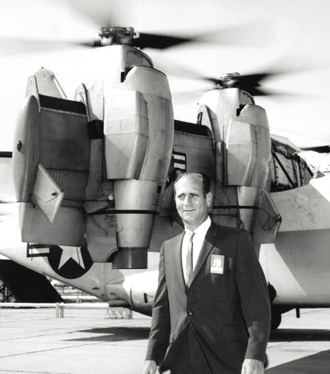
Captain John Konrad spent most of his career as a test pilot, flying aircraft such as this Vought XC-142A.
This Oak Cliff pilot was supersonic
Comment. Visit oakcliff.advocatemag.com/backstory to tell us what you think.
Fourteen-year-old “pilot” John William Konrad Sr. flew his and his friends’ homemade single-wing glider (created in their high school woodshop) through the San Diego night air for a glorious 20 seconds — before careening into a beach sand dune and reducing the plane to a pile of rubbish. All present joined in a huge laugh, and, like most juvenile Depression-era aeronautic engineers would do in those days, they created something usable out of the rubble: They built a bonfire!
To pay for flying lessons, Konrad washed and fueled airplanes during his teenage years, before joining the U.S. Army Air Corps in 1943. With B-17 bomber crews in short supply during that segment of World War II, he was assigned to the 305th bomber group in Germany, followed by flying C-46s and C-54s during the Berlin Airlift, as a commander. After that, Konrad was assigned to serve as a special staff pilot out of Beirut, Lebanon, a part of the United Nations Mediation and Conciliation Commission.
Upon his return from Europe, Captain Konrad was selected for the U.S. Air Force’s first test pilot school, before beginning a four-year stint as a military experimental test pilot. During these years he amassed more than 2,000 jet aircraft hours and 1,000 hours in multi-engine planes and became a fellow and charter member of the Society of Experimental Test Pilots.
When Konrad retired from the service in 1953, Chance Vought Aircraft immediately scooped up the now experienced pilot, which initiated Konrad’s 38-year career with the company — a move that brought the aviator and his family to Oak Cliff and made Vought’s new recruit the youngest test pilot in the country. Within three months, he was promoted to “chief experimental test pilot,” a position he held for the majority of his years with the company. Konrad went on to fly more than 100 aircraft types, but his favorite was the Navy’s F-8U1 Crusader. During the fighter’s maiden flight at Edwards AFB on March 25, 1955, with Konrad at the controls, the aircraft went to Mach-1 supersonic flight, the first time for any maiden flight and a record that still stands. Konrad’s ongoing career with the F-8 earned him the unofficial title of “Mr. Crusader” in Navy circles.
“The F-8 remained in the U.S. Naval inventory until 1986,” relates the pilot’s son, John William “Bill” Konrad Jr., “and its last operational flight was off the French carrier Faunch at the stroke of midnight in 2000 — with a flight of four Crusaders breaking the sound barrier into the new century!”
Following Vought’s F-8 program, “Flight Willie” (Konrad’s control tower “handle”) became the first to fly the A-7 Corsair II. He was the company’s demo pilot for the F-8 and A-7 at both Paris and Farnborough air shows for several years and, in 1964, was instrumental in the initial flight of the armed services’ first vertical take-off and landing aircraft, the XC-142A. He later became Vought’s director of test flight operations.
Konrad not only flew the friendly skies but also flew around Oak Cliff!
According to Bill, after his father’s nationwide recognition for the spectacular F-8 maiden test flight, Konrad gifted himself with a new 1955 turquoise Thunderbird hard-top convertible, which he frequently cruised around Oak Cliff. Soon after, Konrad’s family moved to the Druid Hills housing addition, where Bill and his brother Bobby attended Kimball High School. In the mid-’60s, if a girl was lucky enough to snatch a date with Bill, he often arrived in his dad’s T-Bird — a car to see and a car in which to be seen.
After he retired in 1991, Captain Konrad and his next-door neighbor, Dr. Lloyd Woody, owned and operated Konrad/Woody Aircraft out of Love Field, flying private assignments for large local banks. And every December, the two pilots promoted their “Christmas Light Flight,” taking neighborhood children on air tours to view the city’s holiday illuminations where, Bill states, “There was no charge and no waivers.”
The Texas Aviation Hall of Fame inducted Konrad in 2000, with his original F-8 Crusader and A-7 Corsair on display in the front of the Frontiers of Flight Museum. (The F-8 originally was awarded to the Smithsonian Air and Space Museum.)
In 2002, Konrad moved out of his Oak Cliff home on Holiday Road and passed away in 2006. Now resting with his wife of 55 years, Marilyn, at the Dallas-Fort Worth National Cemetery, the interment service was highlighted by a Scottish bagpipe rendition of “Amazing Grace,” and a fly-by of the Confederate Air Force.
“When[ever] I hear a single-engine fighter in the sky,” Bill reminisces, “I look up and think of ‘The Old Test Pilot.’ He had an aviation career that most aviators would envy. He was my best friend and my hero.”
But the Konrad legacy doesn’t end here.
Bill, a recently retired Continental Airlines pilot, says, “Between Dad and myself, we have a total of 106 years and over 45,000 hours of aviation experience. I think Orville and Wilbur would be proud!”
I think they would, too.





